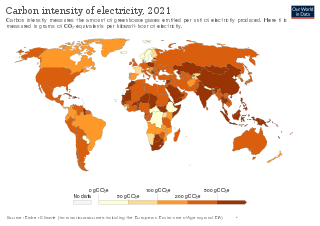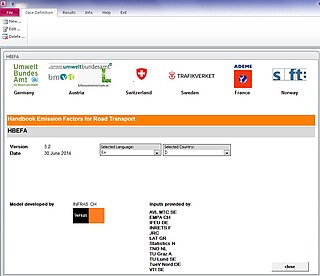
The Convention on Long-Range Transboundary Air Pollution, often abbreviated as Air Convention or CLRTAP, is intended to protect the human environment against air pollution and to gradually reduce and prevent air pollution, including long-range transboundary air pollution. It is implemented by the European Monitoring and Evaluation Programme (EMEP), directed by the United Nations Economic Commission for Europe (UNECE).

The United Nations Economic Commission for Europe is one of the five regional commissions under the jurisdiction of the United Nations Economic and Social Council. It was established in order to promote economic cooperation and integration among its member states.
The California Air Resources Board is an agency of the government of California that aims to reduce air pollution. Established in 1967 when then-governor Ronald Reagan signed the Mulford-Carrell Act, combining the Bureau of Air Sanitation and the Motor Vehicle Pollution Control Board, CARB is a department within the cabinet-level California Environmental Protection Agency.
Vehicle emissions control is the study of reducing the emissions produced by motor vehicles, especially internal combustion engines.

Emission standards are the legal requirements governing air pollutants released into the atmosphere. Emission standards set quantitative limits on the permissible amount of specific air pollutants that may be released from specific sources over specific timeframes. They are generally designed to achieve air quality standards and to protect human life. Different regions and countries have different standards for vehicle emissions.

An emission intensity is the emission rate of a given pollutant relative to the intensity of a specific activity, or an industrial production process; for example grams of carbon dioxide released per megajoule of energy produced, or the ratio of greenhouse gas emissions produced to gross domestic product (GDP). Emission intensities are used to derive estimates of air pollutant or greenhouse gas emissions based on the amount of fuel combusted, the number of animals in animal husbandry, on industrial production levels, distances traveled or similar activity data. Emission intensities may also be used to compare the environmental impact of different fuels or activities. In some case the related terms emission factor and carbon intensity are used interchangeably. The jargon used can be different, for different fields/industrial sectors; normally the term "carbon" excludes other pollutants, such as particulate emissions. One commonly used figure is carbon intensity per kilowatt-hour (CIPK), which is used to compare emissions from different sources of electrical power.

An air quality index (AQI) is an indicator developed by government agencies to communicate to the public how polluted the air currently is or how polluted it is forecast to become. As air pollution levels rise, so does the AQI, along with the associated public health risk. Children, the elderly and individuals with respiratory or cardiovascular problems are typically the first groups affected by poor air quality. When the AQI is high, governmental bodies generally encourage people to reduce physical activity outdoors, or even avoid going out altogether. When wildfires result in a high AQI, the use of a mask outdoors and an air purifier indoors are also encouraged.
The New European Driving Cycle (NEDC) was a driving cycle, last updated in 1997, designed to assess the emission levels of car engines and fuel economy in passenger cars. It is also referred to as MVEG cycle.
A driving cycle is a series of data points representing the speed of a vehicle versus time.

The European emission standards are vehicle emission standards for pollution from the use of new land surface vehicles sold in the European Union and European Economic Area member states and the United Kingdom, and ships in EU waters. The standards are defined in a series of European Union directives staging the progressive introduction of increasingly stringent standards.

The AP 42 Compilation of Air Pollutant Emission Factors is a compilation of the US Environmental Protection Agency (EPA)'s emission factor information on air pollution, first published in 1968. As of 2018, the last edition is the 5th from 2010.

Roadway air dispersion modeling is the study of air pollutant transport from a roadway or other linear emitter. Computer models are required to conduct this analysis, because of the complex variables involved, including vehicle emissions, vehicle speed, meteorology, and terrain geometry. Line source dispersion has been studied since at least the 1960s, when the regulatory framework in the United States began requiring quantitative analysis of the air pollution consequences of major roadway and airport projects. By the early 1970s this subset of atmospheric dispersion models was being applied to real-world cases of highway planning, even including some controversial court cases.
An emission inventory is an accounting of the amount of pollutants discharged into the atmosphere. An emission inventory usually contains the total emissions for one or more specific greenhouse gases or air pollutants, originating from all source categories in a certain geographical area and within a specified time span, usually a specific year.
SAFE AIR is an advanced atmospheric pollution dispersion model for calculating concentrations of atmospheric pollutants emitted both continuously or intermittently from point, line, volume and area sources. It adopts an integrated Gaussian puff modeling system. SAFE AIR consists of three main parts: the meteorological pre-processor WINDS to calculate wind fields, the meteorological pre-processor ABLE to calculate atmospheric parameters and a lagrangian multisource model named P6 to calculate pollutant dispersion. SAFE AIR is included in the online Model Documentation System (MDS) of the European Environment Agency (EEA) and of the Italian Agency for the Protection of the Environment (APAT).
The 1999 Gothenburg Protocol to Abate Acidification, Eutrophication and Ground-level Ozone is a multi-pollutant protocol designed to reduce acidification, eutrophication and ground-level ozone by setting emissions ceilings for sulphur dioxide, nitrogen oxides, volatile organic compounds and ammonia to be met by 2010. As of August 2014, the Protocol had been ratified by 26 parties, which includes 25 states and the European Union.

The Aarhus Protocol on Persistent Organic Pollutants, a 1998 protocol on persistent organic pollutants (POPs), is an addition to the 1979 Geneva Convention on Long-Range Transboundary Air Pollution (LRTAP). The Protocol seeks "to control, reduce or eliminate discharge, emissions and losses of persistent organic pollutants" in Europe, some former Soviet Union countries, and the United States, in order to reduce their transboundary fluxes so as to protect human health and the environment from adverse effects.

The environmental effects of transport are significant because transport is a major user of energy, and burns most of the world's petroleum. This creates air pollution, including nitrous oxides and particulates, and is a significant contributor to global warming through emission of carbon dioxide. Within the transport sector, road transport is the largest contributor to global warming.
The Worldwide harmonized Light vehicles Test Procedure (WLTP) is a global standard for determining the levels of pollutants, CO2 emissions and fuel consumption of traditional and hybrid cars, as well as the range of fully electric vehicles.

Handbook Emission Factors for Road Transport (HBEFA) is a Microsoft Access database application providing emission factors, i.e. the specific emissions in g/km, for all current road vehicle categories. Emission factors are provided for all regulated and the most important non-regulated air pollutants as well as for fuel consumption and CO2. HBEFA is used to estimate road transport emissions on different spatial aggregation levels from national to street level.









